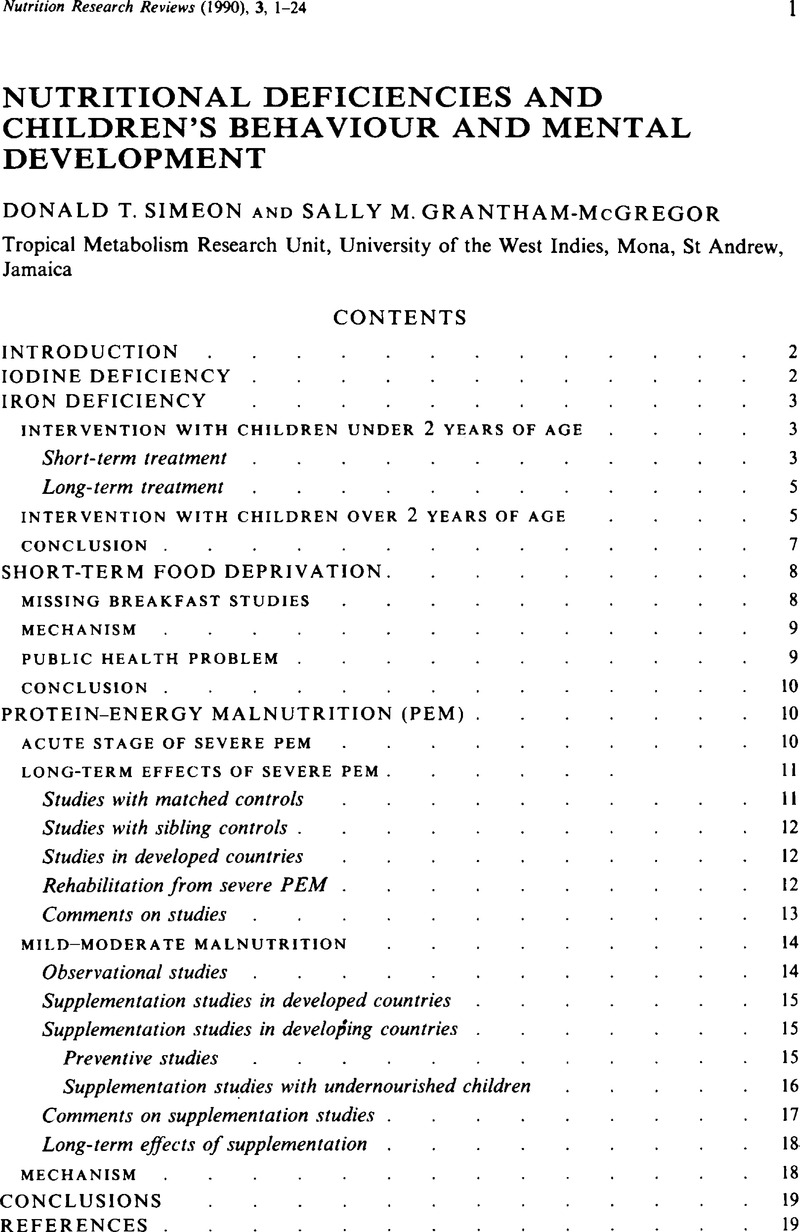Crossref Citations
This article has been cited by the following publications. This list is generated based on data provided by Crossref.
Yudkin, John
1991.
Intelligence of children and vitamin-mineral supplements: The DRF study. discussion, conclusion and consequences.
Personality and Individual Differences,
Vol. 12,
Issue. 4,
p.
363.
Grantham-McGregor, Sally M.
and
Cumper, George
1992.
Jamaican studies in nutrition and child development, and their implications for national development.
Proceedings of the Nutrition Society,
Vol. 51,
Issue. 1,
p.
71.
Connolly, K. J.
and
Kvalsvig, J. D.
1993.
Infection, nutrition and cognitive performance in children.
Parasitology,
Vol. 107,
Issue. S1,
p.
S187.
Callender, J.
Grantham-McGregor, S.
Walker, S.
and
Cooper, E.
1993.
Developmental levels and nutritional status of children with the Trichuris dysentery syndrome.
Transactions of the Royal Society of Tropical Medicine and Hygiene,
Vol. 87,
Issue. 5,
p.
528.
Wachs, Theodore D.
1993.
GOING BEYOND NUTRITION: NUTRITION, CONTEXT, AND DEVELOPMENT.
Monographs of the Society for Research in Child Development,
Vol. 58,
Issue. 7,
p.
100.
Gardner, J. M. Meeks
and
Grantham-McGregor, S. M.
1994.
Physical activity, undernutrition and child development.
Proceedings of the Nutrition Society,
Vol. 53,
Issue. 1,
p.
241.
Stern, J.
and
Wilcox, A.H.
1994.
Scientific Foundations of Biochemistry in Clinical Practice.
p.
253.
Nokes, C.
and
Bundy, D.A.P.
1994.
Does helminth infection affect mental processing and educational achievement?.
Parasitology Today,
Vol. 10,
Issue. 1,
p.
14.
1994.
Abstracts of Communications.
Proceedings of the Nutrition Society,
Vol. 53,
Issue. 3,
p.
158A.
Callender, JE
Grantham‐McGregor, SM
Walker, SP
and
Cooper, ES
1994.
Treatment effects in Trichuris dysentery syndrome.
Acta Paediatrica,
Vol. 83,
Issue. 11,
p.
1182.
Simeon, Donald T.
Grantham-McGregor, Sally M.
Callender, Joy E.
and
Wong, Michael S.
1995.
Treatment of Trichuris trichiura Infections Improves Growth, Spelling Scores and School Attendance in some Children.
The Journal of Nutrition,
Vol. 125,
Issue. 7,
p.
1875.
Gardner, Julie M. Meeks
Grantham-McGregor, Sally M.
Chang, Susan M.
Himes, John H.
and
Powell, Christine A.
1995.
Activity and Behavioral Development in Stunted and Nonstunted Children and Response to Nutritional Supplementation.
Child Development,
Vol. 66,
Issue. 6,
p.
1785.
Ramdath, D. D.
Simeon, D. T.
Wong, M. S.
and
Grantham-McGregor, S. M.
1995.
Iron status of schoolchildren with varying intensities ofTrichuris trichiurainfection.
Parasitology,
Vol. 110,
Issue. 3,
p.
347.
Wachs, Theodore D.
Bishry, Zeinab
Moussa, Wafaa
Yunis, Feisel
McCabe, George
Harrison, Gail
Sweifi, Emtisel
Kirksey, Avanelle
Galal, Osman
Jerome, Norge
and
Shaheen, Farouk
1995.
Nutritional Intake and Context as Predictors of Cognition and Adaptive Behaviour of Egyptian School-age Children.
International Journal of Behavioral Development,
Vol. 18,
Issue. 3,
p.
425.
Robinson, S
Young, RE
and
Golden, MHN
1995.
Electrophysiological assessment of brain function in severe malnutrition.
Acta Paediatrica,
Vol. 84,
Issue. 11,
p.
1245.
Simeon, D. T.
Grantham-McGregor, S. M.
and
Wong, M. S.
1995.
Trichuris trichiurainfection and cognition in children: results of a randomized clinical trial.
Parasitology,
Vol. 110,
Issue. 4,
p.
457.
Lei, Doris Lucia M.
Chaves, Sandra P.
Lerner, Barbara Regina
and
Stefanini, Maria Lucia Rosa
1995.
Retardo do crescimento físico e aproveitamento escolar em crianças do Município de Osasco, área Metropolitana de São Paulo, Brasil.
Cadernos de Saúde Pública,
Vol. 11,
Issue. 2,
p.
238.
Wachs, Theodore D.
1995.
Relation of Mild-to-Moderate Malnutrition to Human Development: Correlational Studies.
The Journal of Nutrition,
Vol. 125,
Issue. ,
p.
2245S.
Rustom, I.Y.S.
López-Leiva, M.H.
and
Nair, B.M.
1996.
Nutritional, sensory and physicochemical properties of peanut beverage sterilized under two different UHT conditions.
Food Chemistry,
Vol. 56,
Issue. 1,
p.
45.
Nokes, C.
1996.
A healthy body and a healthy mind: the relationship between ill-health and cognitive function in school-age children.
Journal of Biosocial Science,
Vol. 28,
Issue. 4,
p.
452.



